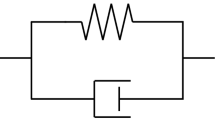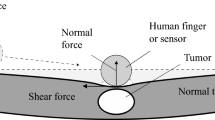Abstract
Purpose
Tactile sensing techniques may distinguish tumor from healthy tissue and have potential for intraoperative brain tumor diagnosis. The aim of this study is to develop a biocompatible real-time sensing system to measure tactile information such as softness and smoothness, and its application to brain tumor diagnosis.
Methods
An active tactile sensor is developed using balloon expansion. This compact system provides instantaneous tactile information and has potential for brain tumor diagnosis. Measurements are obtained on soft samples with different stiffness and surface condition with testing of boundary condition influence on thickness and area of the object. Then, measurements on white matter and gray matter of porcine ex vivo brain are done as the first step for brain tumor diagnosis.
Results
The sensor can discriminate samples with different stiffness and surface condition subject to influence by boundary conditions. The sensor can evaluate an object relatively under the same boundary conditions but requires enough thickness and area to evaluate absolutely. Measurements on brain show that the sensor can discriminate between white matter and gray matter.
Conclusions
Although the sensor has problems on absolute evaluation, results show that the sensor can evaluate tactile information, and it has potential for brain tumor diagnosis.
Similar content being viewed by others
Explore related subjects
Discover the latest articles and news from researchers in related subjects, suggested using machine learning.References
Lee MH, Nicholls HR (1999) Tactile sensing for mechatoronics a state of the art survey. Mechatronics 9: 1–31
Teshigawara S, Tadakuma K, Ming A, Ishikawa M, Shimojo M (2009) High speed and high sensitivity slip sensor utilizing characteristics of conductive rubber—relationship between shear deformation of conductive rubber and resistance change. J Robot Mechatron 21: 200–208
Tanaka Y, Tanaka M, Chonan S (2007) Development of a sensor system for collecting tactile information. Microsyst Technol 13: 1005–1013
Sokhanvar S, Pachirisamy M, Dargahi J (2007) A multifunctional PVDF-based tactile sensor for minimally invasive surgery. Smart Mater Struc 16: 989–998
Schostek S, Schurr M, Buess G (2009) Review on aspects of artificial tactile feedback in laparoscopic surgery. Med Eng Phys 31(8): 887–898
Miller AP, Peine WJ, Son JS, Hammoud ZT (2007) Tactile imaging system for localizing lung nodules during video assisted thoracoscopic surgery. In: Proceedings of the IEEE international conference on robotics and automation, pp 2996–3001
Okamoto J, Okayasu H, Iseki H, Fujie M (2009) Development of volume-controllable pressure sensing balloon: in vivo brain pressure monitoring experiment. Int J Comput Assist Radiol Surg 4(Suppl 1): S116–123
Hemsel T, Stroop R, Uribe DO, Wallaschek J (2007) Resonant vibrating sensors for tactile tissue differentiation. J Sound Vib 308(3–5): 441–446
Zbyszewski D, Althoefer K, Seneviratne L, Bhaumik A (2008) Tactile sensing using a novel air cushion sensor—a feasibility study. In: Proceedings of the IEEE/RSJ international conference on intelligent robots and systems, pp 41–46
Kaneko M, Kawahara T (2004) Co-axis type non-contact impedance sensor. In: Proceedings of the IEEE international conference on robotics and automation, pp 709–714
Tanaka M, Tanaka Y, Chonan S (2008) Measurement and evaluation of tactile sensations using a PVDF sensor. J Intell Mater Syst Struc 19: 35–42
Tanaka Y, Doumoto K, Sano A, Fujimoto H (2009) Active tactile sensing of stiffness and surface condition using balloon expansion. In: Proceedings of the 2nd IEEE international conference on human system interaction, pp 54–59
Tanaka Y, Doumoto K, Sano A, Fujimoto H (2010) Development of a sensor system with syringe based on tactile sensing using balloon expansion. In: Proceedings of the IEEE international conference on robotics and automation, accepted
Johansson S, Westling G (1990) Tactile afferent signals in the control of precision grip. In: Jeannerod M (eds) Attention and performance. Erlbaum, Hillsdale, pp 677–713
Maeno T, Kawai T, Kobayashi K (2003) Friction estimation by pressing an elastic finger-shaped sensor against a surface. IEEE Trans. Robot Autom 20: 222–228
Ogden W (1972) Large deformation isotropic elasticity—on the correlation of theory and experiment for incompressible rubber-like solids. Proc Royal Soc Lond A 326: 565–584
Kikuuwe R, Fujimoto H (2006) Proxy-based sliding mode control for accurate and safe position control. In: Proceedings of the IEEE international conference robotics and automation, pp 25–30
Miller K, Chinzei K (1997) Constitutive modeling of brain tissue experiment and theory. J Biomech 30: 1115–1121
Dommelen JAW, Sande TPJ, Hrapko M, Peters GWM (2010) Mechanical properties of brain tissue by indentation: interregional variation. J Mech Behav Biomed M3: 158–166
Tanaka M (2008) Development of an active palpation sensor wearable on a finger for detecting prostate cancer and hypertrophy. Ann of NanoBME 1: 141–147
Cross SE, Jin YS, Rao J, Gimzewski JK (2007) Nanomechanical analysis of cells from cancer patients. Nat Nanotechnol 2: 780–783
Author information
Authors and Affiliations
Corresponding author
Rights and permissions
About this article
Cite this article
Tanaka, Y., Yu, Q., Doumoto, K. et al. Development of a real-time tactile sensing system for brain tumor diagnosis. Int J CARS 5, 359–367 (2010). https://doi.org/10.1007/s11548-010-0426-7
Received:
Accepted:
Published:
Issue Date:
DOI: https://doi.org/10.1007/s11548-010-0426-7




